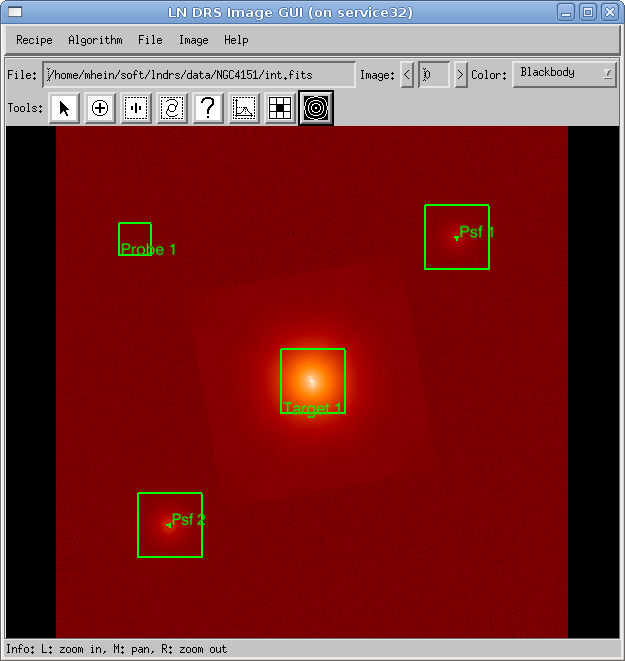 |
Before extracting a psf from the preprocessed images, at least one psf star must be marked in the first image of each file. In the provided example, two psf stars are already marked and ready to use. The psf preprocessing is executed like the target preprocessing step. The psf preprocessing needs the part of the preprocessed data containing at least one psf star and some additional information (e.g. sky background) as an input. Normally, the following steps are necessary:
In figure 1, an image window shows the target in the center, two psf stars near the corners and an image probe in the upper left corner. The image probe is used to estimate the sky background in the image. Alternatively, an image probe in a sky image can be used.
 |
The purpose of the psf star tool (see section Tools) is to specify at least one psf star in the first image of each preprocessed data file. This psf star is used to cut out the part of an image later used for reconstruction. The psf star definition is the major input for the Psf Preprocessing step.
| Mouse button | Function |
|---|---|
| Left click | Creates a new psf star centered at the mouse position. |
| Middle click | Shows a dialog window with the details of the selected psf star (figure 2). |
| Right click | Removes the psf star at the selected position. |
| Middle drag | Moves the selected psf star to a different position. |
| Control left click | Enlarges the selected psf star by a factor of 2. |
| Control right click | Shrinks the selected psf star by a factor of 2. |
| Shift left click | Zooms into the image and the click position becomes the new image center (from view tool). |
| Shift middle click | Uses the click position as the new image center (from view tool). |
| Shift right click | Zooms out of the image and the click position becomes the new image center (from view tool). |
| Shift middle drag | Moves the image (from view tool). |
In the preprocessed data, at least one psf star must be defined. If more stars are used as psf stars, either the quality of the extracted psf will increase or a space variant psf can be used for deconvolution. When selecting the graphic object with the middle mouse button (psf star tool) or the left mouse button (info tool), a dialog box appears which contains all parameters for that psf star (figure 2, right panel)
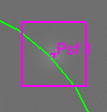 | 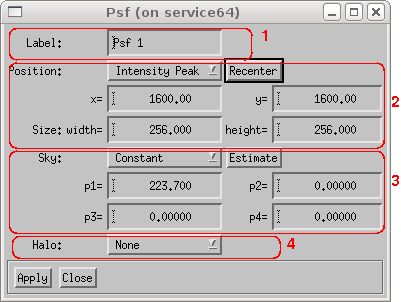 |
The psf star dialog box contains the following elements:
The sky background must be defined even if it will be kept during the psf extraction, because some algorithms need the background level. The overall shape and the respective parameters must be specified in the dialog window.
Sometimes a bright or extended target shows an extended halo, which can influence one or more psf stars. The halo must be removed from these psfs. The basis for this compensation is the target halo. It defines an area of the preprocessed image where the target halo is smooth and symmetric and can therefore be removed. The target halo tool (see section Tools) allows the creation and modification of such a target halo.
| Mouse button | Function |
|---|---|
| Left click | Creates a new target halo centered at the mouse position. |
| Middle click | Shows a dialog window with the details of the selected target halo (figure 3). |
| Right click | Removes the target halo at the selected position. |
| Middle drag | Moves the selected target halo to a different position. |
| Control left click | Enlarges the selected target halo by a factor of 2. |
| Control right click | Shrinks the selected target halo by a factor of 2. |
| Shift left click | Zooms into the image and the click position becomes the new image center (from view tool). |
| Shift middle click | Uses the click position as the new image center (from view tool). |
| Shift right click | Zooms out of the image and the click position becomes the new image center (from view tool). |
| Shift middle drag | Moves the image (from view tool). |
In the preprocessed data, only one target halo can be defined and used. The graphical representation is shown in figure 3. When the graphic object is selected with the middle mouse button (halo tool) or the left mouse button (info tool), a dialog box containing all parameters for that target appears (figure 3, right panel).
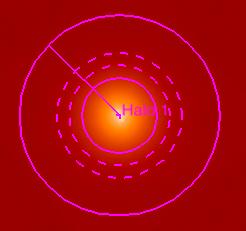 | 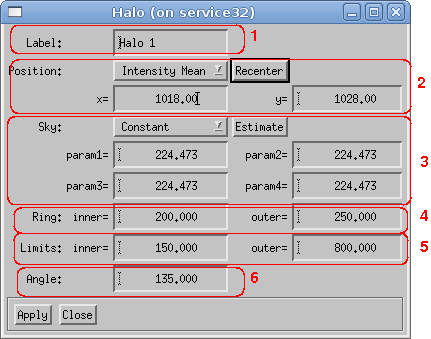 |
The halo dialog box contains the following values:
Because the sky background at the halo position can differ from the background at the psf star position, it is only necessary to compensate for the halo component. The sky background at the halo position must therefore be defined. Recentering the halo uses an approach in which only the pixels between the two dashed circles are used to calculate the intensity mean.
The psf preprocessing is carried out like the target preprocessing step. The algorithm-specific dialog window is presented in figure 4; an extracted psf is shown in figure 5.
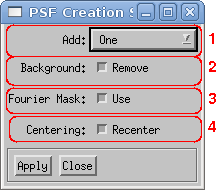 |
The setup dialog box contains the following elements:
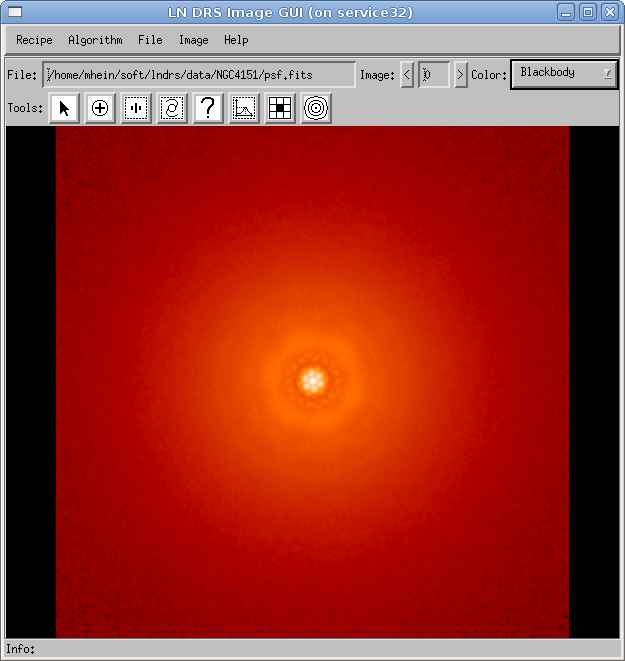 |
Additional information: